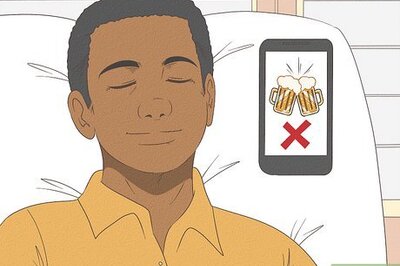
views
In urban India, vaccine hesitancy noted since January 2021 was replaced by vaccine urgency in April and vaccine anxiety in May. Non-availability of vaccines to several vaccination centres led to their temporary closures. The opening up of vaccination to the entire adult population above 18 years led to a further mismatch between demand and supply. Smaller towns and villages are yet to a display a swelling demand, due to both vaccine hesitancy and the barriers posed by the technology gateway mandated for registration. Equity demands that people there too must be supplied and administered vaccines, soon after they are assisted for early and expanded enrolment.
We are assured by the central government that vaccine supplies will increase by August 2021, with ramped up production of already approved vaccines and entry of several new vaccines. Availability of 2 billion doses, by December 2021, has been forecast. This is contingent on the present manufacturers picking up pace fast and the new vaccines getting the green flag from the regulator after successfully qualifying in the trials. We have to wait to see if this best-case scenario unfolds in reality.
While some state governments have launched global tenders for vaccine purchase, supply is constrained even internationally. The COVAX facility is facing a huge shortage and is unable to meet its commitments to developing countries, especially those in Africa. The WHO has demanded that Serum Institute of India must meet its obligations to COVAX. Rich and middle-income countries are competing with each other to draw on the available global supplies, while low-income countries are unable to access. While the United States may divert some of its unused AstraZeneca vaccines to India, it will be a very little increment to India’s stocks while the vaccine demand for universal adult immunisation is huge.
The question that is weighing on many minds is “what do we do until mid-August when the vaccines may flow into the supply pipeline with greater volume and speed?” This question is linked both to concerns about personal protection from the disease and speculation about the extent to which economic activities can resume without large-scale vaccination. Social life too will have an uncertain calendar, whether for opening schools, conducting weddings or undertaking unhindered domestic or international travel.
Simple Steps We Can Follow
The answer is clear and simple. Public health precautions for containing person-to-person transmission are relevant, essential and valuable before, besides and beyond vaccines. Wearing masks and avoiding crowds are the mantras of personal protection that have to stay with us for several months more. Opening up homes, offices, factories, shops, schools and colleges to air flow, through better ventilation, will be needed to reduce risk of viral spread through aerosols. This change must acquire permanency, even as we determinedly act to reduce outdoor and indoor air pollution which increases the risk of lung damage in COVID, besides aggravating inflammation and undermining immunity. Aerosols spread the infection for distances over six feet. They can drift in buildings through slow-moving viral clouds. Briskly moving flowing air currents, created by cross ventilation, prevent such clouds from lingering and disperse the virus particles before they can conspire to crowd together. Persons working or meeting in closed spaces should double mask.
Super-spreader events have to be stalled before they start, through unwavering political will and determined administrative action, apart from effective public messaging. Elections would need to be postponed or permitted with only minimal local canvassing rather than mega-rally campaigning. People may be advised to celebrate festivals at home with piety and sobriety than with boisterous public processions and milling crowds at melas.
We must recognise that even the arrival of larger supplies of vaccines in August 2021, as promised, will not deliver us immediate protection. At the individual level, the vaccine will take a few weeks to produce a strong immune response. The level of the immune response will also vary with the type of vaccine used, number of doses given, the interval between the two doses, the age and nutritional status of the person and the presence of any co-morbidities. At the community level, several persons will have to be vaccinated before impact is seen on reducing viral transmission.
The Vaccination Strategy We Need
The primary purpose and proven benefit of vaccination is to protect a person against severe disease and death. So, persons who are vulnerable to severe disease must be accorded high priority. These are persons over 45 years of age and younger persons with known co-morbidities. Only when we are assured of an abundant and uninterrupted supply of vaccines should we start moving down the age groups. By the end of 2021, we are also likely to receive the results of recently initiated vaccine trials in young children. If those trials demonstrate efficacy and safety in children as young as 6 months, virtually all of India’s population will be eligible for vaccination. We will need an even more abundant supply of vaccines then.
There are several new candidate vaccines undergoing global trials, besides the ones on the anvil in India. Some of them are older ones which have been tweaked to have greater efficacy against new variants. Others are adopting new approaches to eliminate the risk of infection and not just minimise the risk of severe disease. These are mucosal vaccines which are inhaled rather than injected. They can protect the respiratory tract from the initial assault by the virus, unlike the presently available injectable vaccines which produce strong systemic immunity but do not create a mucosal barrier through secretory antibodies. Such mucosal vaccines will also be easier to administer to children. Single-dose packaging syringes also may arrive later in the year, to reduce vaccine wastage from multi-dose vials. Indian authorities, at central and state levels, must be on the look out to bid for and procure some of these new vaccines even as we attempt to ramp up our domestic production.
Our vaccine supply position can also improve after a few months, if we get patent waivers, as proposed by India and South Africa at the World Trade Organisation. Several developing countries support this proposition. The United States, which had opposed this earlier, has now announced its support for a limited waiver. If this proposal is accepted at the World Trade Organisation, it would open several opportunities for Indian companies to manufacture difficult-to-procure foreign vaccines. Even if the WTO process stalls, the Indian government can issue compulsory licenses, as permitted by Doha Declaration of the World Trade Organisation which permits such an action during public health emergencies.
Managing Vaccine Urgency & Hesitancy
One lesson that has emerged clearly during this COVID crisis is that India’s public sector capacity must be built up again for vaccine manufacturing. We cannot be dependant only on the private sector capacity, valuable as it is. Even for receiving and acting on compulsory licensing, public sector capacity would be needed if private companies are daunted by the potential challenge of taking on large foreign vaccine manufacturers. If India has to restore its reputation as a dependable global vaccine supplier, expansion of our manufacturing capacity is a must. Such augmented capacity has to become visible and stay viable in both public and private sectors.
While we wait for our vaccination programme to gain volume and speed, we must live with the reality that our protection will still depend on the measures that have been advocated even before validated vaccines emerged from clinical trials to fill vials and syringes. We need to urge those who are exhibiting vaccine urgency to adopt safe public health practices with patience and resilience, even as we build vaccine confidence among the many who are uncertain about offering their arm to the vaccine when their turn comes.
Read all the Latest News, Breaking News and Coronavirus News here. Follow us on Facebook, Twitter and Telegram.



















Comments
0 comment